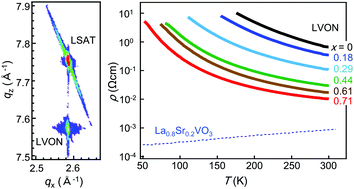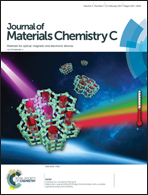Strong carrier localization in 3d transition metal oxynitride LaVO3−xNx epitaxial thin films†
Abstract
Perovskite LaVO3 is a typical Mott insulator that exhibits insulator to metal transition by hole doping via substitution of an alkali earth element for La (La1–xSrxVO3 or La1−xCaxVO3). In this study, we investigated the electrical transport properties of its anion-substituted counterpart, LaVO3−xNx (0 ≤ x ≤ 0.71). LaVO3−xNx epitaxial thin films with high crystallinities and smooth surfaces were grown by plasma-assisted pulsed laser deposition. The electrical resistivity (ρ) of the thin films was remarkably lower than previously reported values for bulk polycrystals of LaVO3−xNx, indicating a suppressed contribution of the resistive grain boundaries to ρ in the present films. Plots of ρ against temperature for the LaVO3−xNx thin films showed that they were insulating (dρ/dT < 0) even at the highest doping level (x = 0.71), which is much larger than the threshold values for insulator to metal transition in La1−xSrxVO3 (x = 0.18) and La1−xCaxVO3 (x = 0.3). The curves of ρ against temperature were well described using the Efros–Shklovskii-like variable range hopping model, suggesting that random potential introduced by N substitution in the VX6 conduction path induces strong carrier localization in LaVO3−xNx.



 Please wait while we load your content...
Please wait while we load your content...